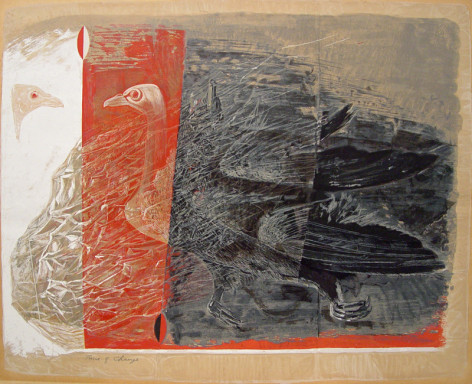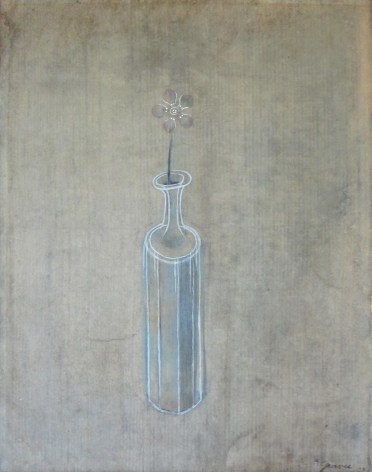Morris Graves

Time of Change, circa 1944
Morris Graves (1910 – 2001)
Morris Graves, an artist whose paintings of wounded birds and supernaturally radiant flowers combined the spirit of American Transcendentalism with Asian philosophy, and whose reclusive efforts to avoid what he called “the machine- age noise of America” were the stuff of legend, died on Saturday at his home in Loleta, Calif. He was 90.
Often associated with a group of painters from the Pacific Northwest, among them Mark Tobey, Mr. Graves became an overnight sensation in 1942 when his work appeared in a show of new American talent at the Museum of Modern Art. At the time, he was living on an island in Puget Sound in a barely accessible clifftop house once described as a cross between a fisherman’s shack and a Japanese tea house. He had built it himself. It had no electricity; the only available water was rainwater, and Mr. Graves’s only companion was a small dog named Edith.
He painted certain images repeatedly. They included woodland animals and insects whose expressive forms in abstract settings often projected intense emotions. After the 1960′s, when his views of the world had mellowed, he produced still lifes of flowers, vegetables, and Chinese ritual bronzes bathed in soft light.
Although his work was influenced by Asian spiritual traditions, among them tantric Hinduism, Daoism, and particularly Zen Buddhism, its eclectic stylistic sources were primarily Western. They included Surrealism, Art Nouveau, and Tobey’s abstract “white writing,” script-like lines of white paint. Whatever the mix, the results lay well outside the Modernist mainstream.
Mr. Graves was born on August 28, 1910, in Fox Valley, Ore., and grew up in the Puget Sound region. He remembered his father, a homesteader, as a Whitmanesque figure, though he himself was a sickly child who spent much of his time fantasizing garden designs. He dropped out of high school after two years to work as a seaman, a job that took him to Japan and China three times between 1929 and 1931. Thereafter he was a world traveler.
Biography
In his early 20′s he resumed high school while living with an aunt in Beaumont, Texas, where he took one of the few painting courses in a largely self-taught career. He came to school barefoot, and was described in his class yearbook as “a vagabond artist with a commanding mien rushing here or there with flowers or canvas in hand.” After working on the Federal Arts Project, he went to New York in 1937, hoping to find a patron.
Having no success, he returned to Seattle, where he met the composer John Cage, who was working as a piano accompanist for dance students at the Cornish School. He and Cage, who shared an interest in Zen Buddhism, became close friends.
At his island home, The Rock, he painted the emblematic images of birds known as the “Inner Eye” series, among his best-known works. They were seen in Seattle by a visiting New York art dealer, Marian Willard Johnson, and by Dorothy C. Miller, a curator at the Museum of Modern Art. In 1942, Ms. Johnson gave him his first one-man East Coast show at her gallery, the Willard Gallery, and Ms. Miller included him in “Americans 1942: 18 artists from 9 States,” a show at the Modern that established his career.
Later that year he was drafted, and after declaring himself a pacifist, was confined to a guardhouse for 11 months. In 1947, he left the Rock when a naval base was built nearby; its flights passed directly over his house. He moved closer to Seattle, but the noisy construction of postwar housing developments drove him away.
He settled outside Dublin, but left there as well.
In 1964 he moved to Loleta, in Northern California, where he bought 25 acres of virgin redwood forest, created a lake, erected Japanese-style buildings, and planted the gardens that were one of his obsessions.
By this time, both Mr. Graves and his art had changed. He had always been what one friend described as a “sociable recluse,” with many friends, long-distance and otherwise. With age he became more resigned to the insistent presence of technology: “You simply can’t keep the world out any longer,” he told the writer Katherine Kuh.
He moved away from anguished and ecstatic images of animals and turned to spare, richly colored floral paintings, of which he said, “there is no statement or message other than the presence of flowers and light.”
His reputation, which faded dramatically after the 1950′s, still made some mark internationally. He visited Indira Gandhi and her father, Prime Minister Jawaharlal Nehru, in New Delhi. The Duke and Duchess of Windsor made him the first American recipient of the Windsor Award for artists, and he spent a Thanksgiving with them at their house near Paris. Their mutual passion for horticulture gave them much to talk about, he said.
Mr. Graves had dozens of solo museum shows, including retrospectives at the California Palace of the Legion of Honor in San Francisco in 1948, the Whitney Museum of American Art in 1956 and the Phillips Collection in Washington in 1984. He was represented by the Willard Gallery from 1942 until it closed in 1988, and then by the Schmidt-Bingham Gallery, also in Manhattan.
He created the Morris Graves Foundation, which will turn his idyllic home, the Lake, into an artists’ retreat. Its director, Robert Yarber, who was Mr. Graves’s friend and assistant for nearly 30 years, describes it as a place for “rest, inspiration, work and contemplation.”
He is survived by a sister, Celia Leary of LaSelva, Calif., and a brother, Russell Oscar Graves of Oakland, Calif.
As for his own work, Mr. Graves once told Mr. Yarber that of the large number of paintings he had produced in a prolific career, maybe five or six were good. “And they painted themselves,” he said. “All the rest were by Morris Graves.”
Addendum:
Weeks after the death of artist Morris Graves – the last of the so-called
“Northwest Mystics” who came to prominence in the 1950s – his Skagit County, Washington studio-retreat burned to the ground. Property caretaker Terry Smith died in May 24′s fire, Chief Mike Noyes of Skagit County Fire District 11 told the Associated Press.
The above obituary is from The New York Times, by Holland Cotter.
Biography from the Archives of AskART

